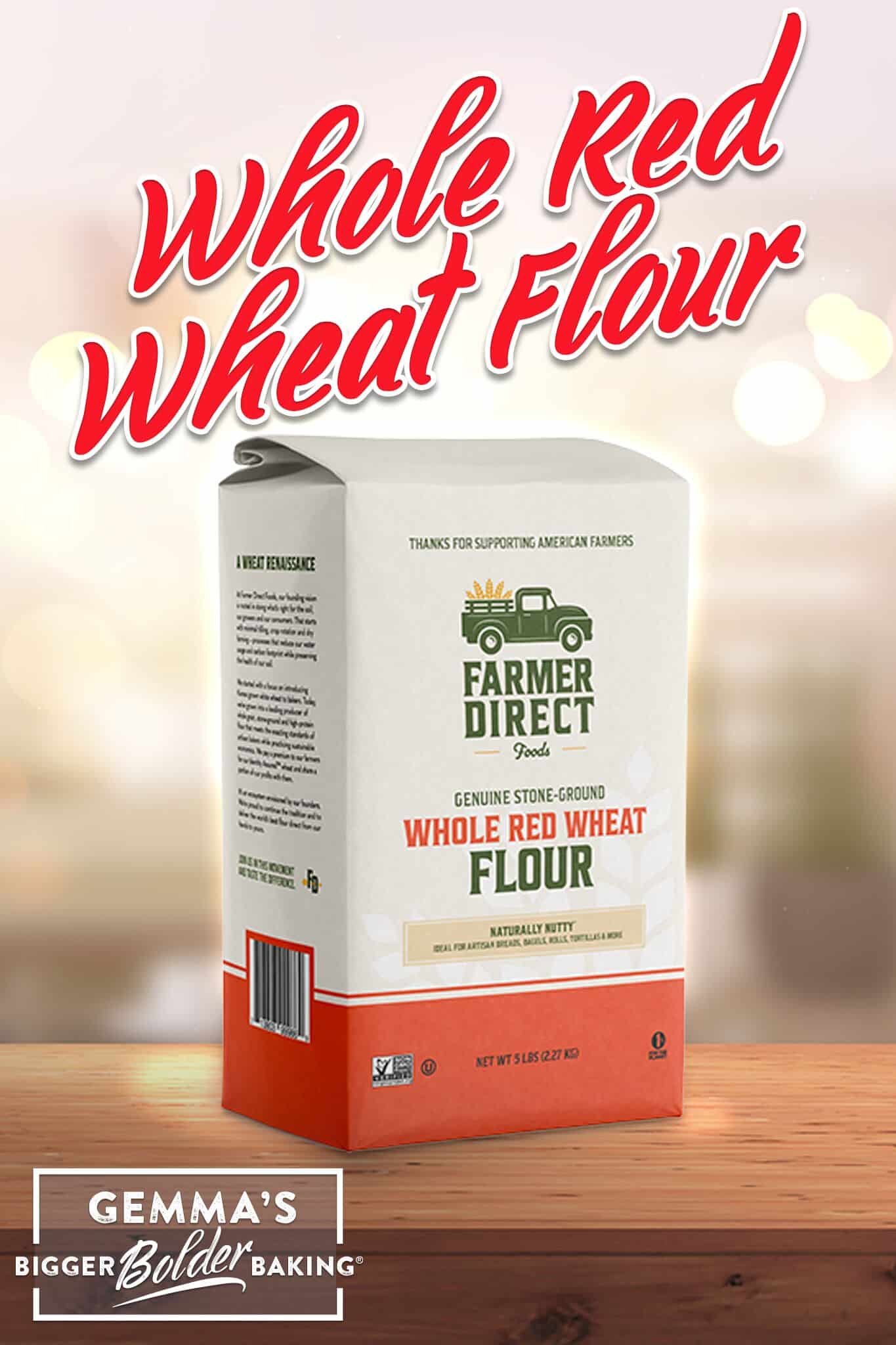
This post may contain affiliate links. Please see my full disclosure for details.
Hi Bold Bakers!
In the world of baking, your choice of flour can make all the difference, and we’re here to provide you with the Ultimate Guide to 10 Types of Flour for Baking including the differences and how to use them, so you can make informed decisions. As bakers ourselves, we know how crucial it is to have access to the best and most comprehensive baking flour chart that every baker needs. Read on for more information and a FREE downloadable guide.
With countless baking flour options available, even seemingly subtle choices can have a significant impact on your outcomes. That’s why we’re proud to partner with Farmer Direct Foods who joined us to curate a list of 10 commonly available flours, offering you the knowledge and insight you need to take your baking skills to the next level.
Farmer Direct Foods focuses on regenerative farming practices, producing genuine stone ground, whole wheat flours that offer benefits for home bakers, farmers, and the environment. These nutrient-rich flours create healthier, more flavorful baked goods while positively impacting sustainability. Now let’s help you bake bolder and better.

All Purpose Flour (aka White Flour or Plain Flour)
Protein content: 11.5%-12.5%
Characteristics: provides soft structure and a neutral taste
Best uses: cakes, cookies, muffins, pie crust, pizza dough
- All-purpose flour is made from hard red wheat or a combination of hard red winter wheat and soft white wheat.
- During milling, the germ and hard outer bran layer are removed from the wheat berries, leaving just the endosperm to be ground into flour. Then the fresh flour must either go through an aging or bleaching process before it can be used.
- Aged flour (also known as unbleached flour) is exposed to oxygen for several weeks or months, and this lightens the grain, strengthens the protein, and makes it easier to work with.
- Although banned in Europe and other parts of the world, since the aging process can take so long, some countries (the United States included) have allowed chemical bleaching. Not only does this lighten the grain in a matter of hours, but it also makes the flour more acidic, softer, and more absorbent when compared to unbleached flour.
- While either bleached or unbleached all-purpose flour can be used interchangeably when making a cake in particular, bleached flour will give softer, fluffier, and more tender results.
- All-purpose flour is the best choice for these Bigger Bolder Baking recipes:
Self-Rising Flour for Baking (aka Self-Raising Flour)
Protein content: 8%-9%
Characteristics: creates tender baked goods with a nice rise
Best uses: biscuits and scones
- Self-rising flour was developed in England in the mid-19th century as a convenience for the British Navy but has since become a beloved staple in many recipes that come from the American South, particularly for biscuits.
- It is very finely milled from the endosperm of soft red winter wheat. The gluten percentage is much lower than that of all-purpose flour (which is milled from the higher protein hard red winter wheat).
- Baking powder and salt are added to the flour, making additional leavening usually unnecessary.
- The low gluten and fine texture of this flour make exceptionally light, tender, and high-rising biscuits and scones.
- Because of the leavening in self-rising flour, we don’t recommend swapping out another type of flour for this if you don’t have any on hand. In this case, the best thing to do is find a recipe that does not require self-rising flour.
- But, if there is a recipe you really want to try, you can make your own close approximation of self-rising flour by combining 1 cup (5 oz/142 g) of all-purpose or cake flour with 1½ teaspoons of baking powder and ¼ teaspoon of salt. (The result won’t be exactly the same: all-purpose flour has a higher gluten content and is less finely milled, so will give you less light and tender results. Cake flour is milled from a different wheat berry, so these results will also be a little different.)
- Self-rising flour is the flour of choice in these Bigger Bolder Baking Recipes:
Cake Flour for Baking
Protein content: 7%-9%
Characteristics: provides delicate structure and a very tender, fine crumb
Best uses: all cakes (butter, pound, sponge, angel food)
- Cake flour is made from the endosperm of soft white wheat. These wheat berries have a lower protein content (and therefore less gluten) than that of hard red or hard white wheat. This flour is milled extra fine which allows for greater absorption of liquid and more even distribution of fats. This combined with the low gluten content makes beautifully textured cakes that are fine-crumbed, soft, tender, light, and fluffy.
- Cake flour can be found bleached or unbleached.
- Both will make tender cakes, but the bleached flour will be even more so.
- Because of how well cake flour absorbs liquid, it can have a drying effect on recipes that are developed using all-purpose flour but this has not been taken into account.
- Since we don’t have a formula for how much extra liquid you should add to a cake batter if want to use cake flour, we suggest you find a recipe that calls for cake flour instead of doing a direct swap out with all-purpose. You can find a recipe for a cake flour substitute here. Keep in mind that because the substitute uses all-purpose flour which is less finely milled, the results will be delicate but not as fine-crumbed.
- See how wonderful this flour can be in these Bigger Bolder Baking recipes:
Bread Flour for Baking (aka Strong Flour)
Protein content: 12%-14%
Characteristics: higher gluten content provides greater elasticity, giving doughs a good lift, strong structure, and chewy texture.
Best uses: bread, pizza dough, pretzels, bagels
- Bread flour is milled from the endosperm of hard red spring wheat. This is harder than red winter wheat and has a higher protein content when compared to all-purpose flour.
- The high protein content resulted in high gluten.
- Gluten provides strength in the form of elasticity. When baking bread, the gluten will allow the dough to stretch around the escaping steam, like a balloon, creating air pockets and lift. For comparison’s sake, all-purpose flour can be a bit more brittle or tender, and escaping steam will break through the surface more easily, creating a smaller, denser loaf.
- The elasticity in the gluten also provides bread products with a satisfying, chewy texture.
- All-purpose flour can be used to bake bread if you don’t have any bread flour on hand. Or, to make a bread flour substitute, combine 1 cup (5 oz/142 g) all-purpose flour with 1 teaspoon of vital wheat gluten.
- Explore using bread flour in these Bigger Bolder Baking recipes:
Pastry Flour for Baking
Protein content: 8%-10%
Characteristics: provides tenderness and structure somewhere between all-purpose and cake flour
Best uses: pie crust, pastries, biscuits
- Pastry flour can be found as whole wheat flour, milled from whole soft white wheat, or as an unbleached white flour made from the endosperm of a combination of soft white and soft red wheat.
- As indicated by the protein content, it is a perfect middle ground between tenderness and structure, making this flour the best choice for flaky and tender pie crusts, biscuits, pastries, and some cookies.
- Whole wheat pastry flour is a great choice when you want to include more whole grains in baking while also keeping things lighter and more tender than traditional whole wheat flour. It works very well for making whole wheat pancakes, muffins, scones as well as savory pies.
- However, we don’t recommend this flour for baking whole wheat bread, where higher gluten content is required.
- You can use pastry flour (either whole wheat or white) in place of all-purpose flour in these Bigger Bolder Baking Recipes:

Rye Flour for Baking
Protein content: 10%-15%
Characteristics: nutty, earthy, slightly sour flavor with a dense texture
Best uses: rye breads, sourdoughs, gingerbreads and crackers
- Rye is not a wheat variety but it is great for creating fully flavored, rustic, hearty loaves of bread and crackers.
- It has a higher amount of protein and fiber than wheat but it is much lower in gluten. Gluten is the protein that creates elasticity when combined with water, and this is necessary when making chewy, airy loaves of bread.
- For this reason, rye is a terrific addition to bread doughs but should be used in small amounts and in combination with wheat flour or your end result can be dense and crumbly.
- However, if chewiness is not a factor, as in with biscuits, crackers, and cookies, for example, rye can work quite well in larger amounts.
- In sweet baked goods, rye’s robust flavor makes it pair quite well with stronger flavors like chocolate, caramel, and ginger. Try swapping out some rye flour in chocolate chip cookies or spiced gingerbread.
- Farmer’s Direct makes an excellent stone ground rye flour for all of your baking needs and it’s delicious in my Steakhouse Style Pumpernickel Bread.

Heirloom Wheat Flour for Baking
Protein content: 10.5%
Characteristics: finely textured with a robust wheat flavor
Best uses: sourdough, pizza dough, brownies, cookies
- Heirloom wheat consists of different varieties of wheat that were grown before modern breeding techniques and chemical fertilizers greatly altered the crops in the 20th century for significantly higher yield and mass production of breads and cereals.
- Modern wheat berries are bred to be larger, starchier and with a much higher gluten content than traditional wheat. The shorter wheat stalks are also better able to handle a greater amount of fertilizer without falling over. If all this does not sound like something you would want to ingest with your morning coffee, then heirloom wheat is the choice for you.
- Farmer’s Direct sells heirloom wheat flour milled from Turkey Red Wheat which came to the US from Russian Mennonite farmers. It has a much lower gluten content than modern wheat which makes it easier to digest, and it boasts a full, wheaty flavor and fine texture that makes it a great choice for sourdough breads, pizza doughs, brownies, cookies, and breakfast bakes.
- Heirloom whole wheat flour, like all whole wheat flour, is not the best choice for more delicate cakes or pastries, but you can use this flour in any recipe where whole wheat flour is asked for.
- You can also use this in place of all-purpose flour but you should expect a heartier, somewhat denser end result. This is a great choice of flour for these Bigger Bolder Baking Recipes:

Whole White Wheat Flour
Protein content: 10%-12%
Characteristics: whole grain with a mild, sweet flavor, light color, and soft texture
Best uses: yeasted breads, tortillas, pizza dough, pancakes and muffins
- White whole wheat flour was first introduced to the United States by Farmer Direct Foods in 1988.
- It is milled from whole hard white winter or spring wheat berries. Although 100% whole grain, it has a slightly lower protein content than red wheat.
- When compared to traditional whole wheat flour, it produces bread and other baked goods with a milder, sweeter flavor, lighter color, and softer texture.
- This is the perfect flour to use if you wish to include healthy whole grains into your diet but find red whole wheat a bit too overpowering.
- White whole wheat can be used in any recipe that asks for whole wheat flour.
- Its slightly lower gluten content may result in a lower rise in breads, but this can be remedied by the addition of vital wheat gluten (1 teaspoon per cup (5 oz/142 g of white whole wheat flour) or by using half white whole wheat and half either traditional red whole wheat or bread flour.
- Try using white whole wheat flour in these Bigger Bolder Baking recipes:
- Artisanal Whole Wheat Bread
- Whole Wheat Sandwich Bread
- Buttermilk Pancakes Recipe (You can also swap out half of the all-purpose flour with white whole wheat flour for a nutritional boost.)

Whole Red Wheat Flour
Protein content: 12.5%-13.5%
Characteristics: whole grain with a nutty flavor, brown color, and hearty, chewy texture
Baking Flour Best uses: yeasted breads, flatbreads, chapatis, tortillas
- Whole red wheat flour is what many of us associate with traditional whole wheat flour.
- It is milled from the whole hard red wheat berry, including the germ and bran.
- It is the germ and bran that gives whole wheat its characteristic speckled brown color, hearty and somewhat denser texture, and a full, almost nutty taste.
- Its higher gluten content makes breads that are nice and chewy.
- Whole wheat flour can be milled through stone grinding, an ancient form of milling that produces larger bran and germ particles and creates a more textured baked good. Or it can go through a modern roller milling process which can produce a slightly finer result.
- When baking bread, whole wheat flour can be partly or fully substituted for all-purpose or bread flour, but whole wheat flour will absorb more liquid and you will therefore need more water in the dough.
- The best way to figure out how much is to first mix up your dough according to the recipe. Cover the dough and let it rest for a half hour, then check the consistency. If the dough seems stiff or dry, then knead in more liquid, a little bit at a time, until a soft dough is achieved (or whatever consistency that the recipe asks for.)
- Keep in mind that not all flours are created equal: Farmer Direct Foods practices regenerative farming and provides high-quality, eco-friendly whole red wheat flour that is stone ground and delicious.
- Try this flour with these Bigger Bolder Baking Recipes:
Semolina Flour (Durum Wheat Flour)
Protein content: 12%-14%
Characteristics: coarse flour made from durum wheat, a hard wheat variety with a mild nutty flavor, a higher protein content, and a harder texture.
Best uses: pasta, bread, pizza dough, and Italian desserts
- Semolina flour is a coarse flour made from the endosperm (the starchy part) of durum wheat.
- The wheat kernels are cleaned, tempered with water, and then ground to produce semolina flour.
- Semolina flour has several distinctive characteristics:
- Semolina is coarser than all-purpose or bread flour, giving it a slightly gritty or sandy texture. This texture is ideal for dusting bread to prevent dough from sticking to the working surface or bakeware: No-Knead English Muffins or Sourdough Pizza Crust.
- Durum wheat is a hard variety of wheat, which means it has a higher protein content and a harder texture compared to other wheat varieties.
- It has a slightly yellow color due to the carotenoid pigments in the durum wheat. This color can enhance the appearance of dishes made with semolina such as a golden pizza crust.
- Semolina has a mild, nutty flavor, which can add depth to recipes.
- The coarseness and high protein content of semolina make it an excellent and ideal choice for making pasta. It helps the pasta maintain its structure and “al dente” texture. Try these Bigger Bolder Baking Recipes:
Click/Tap to Download the Ultimate Guide
Flour is a basic building block of the majority of baked goods, and is used to create components of so many meals around the world. With an abundance of flour varieties at your disposal, Farmer Direct Foods remains dedicated to providing sustainable, nutrient-rich artisanal flours, supporting your culinary journey. We at Bigger Bolder Baking hope all of this information helps clear the path towards many baking adventures in your future.








Thank you so much for the article. I have recently started using Italian and French flours and was desperately trying to figure out how to use them for baking American treats (chocolate chip cookies, pies, etc) and this saved me. The chart at the end was especially helpful, thank you again!
I’m looking for a flour made from wheat that has not been sprayed with Roundup. Any ideas how to tell?
I am an American living in europe (Austria) and I have had such a hard time with flour here…especially with cakes and cookies…being that you are from Ireland and probably familiar with the differences so you have any suggestions?
This chart and other information is very helpful to those of us who try to eat healthy ancient grains. Great information!
How do you order from Farmers direct? Sorry, I might have missed something.
Great Article Gemma, Nice to have it all in one place. Thank you!
Hi Gemma. I’m a bit confused by the flour recommendation for scones. The flour guide shows its best to use self rising flour for your scones and provides a link to the recipe, but the recipe itself shows all purpose flour. Which is better? (I’ve made so many of your recipes and they’ve all turned out extremely well.) Thanks. Tricia